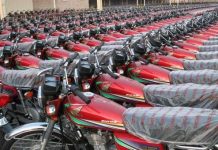ISLAMABAD: A sudden and ferocious hailstorm lashed Islamabad and its surrounding areas Monday afternoon, causing widespread destruction—particularly in the northwestern sectors of the city—where the brunt of the impact was felt. The storm inflicted serious economic losses, damaging solar energy infrastructure, private vehicles, and residential properties, while also disrupting power supply and urban mobility.
The severe weather system brought torrential rains, powerful gusts of wind, and large hailstones that pummeled rooftops and roads for several minutes. In its wake, streets in sectors such as E-11, G-11, and F-10 were littered with shattered glass, broken branches, and twisted solar panel frames.
One of the most affected assets were solar carports—charging stations designed for electric vehicles—as the hailstorm shattered photovoltaic panels and bent steel frames. Several of these structures, which are part of Islamabad’s push toward sustainable urban transport, were rendered inoperable. Initial estimates suggest losses running into tens of millions of rupees for both public and private operators.
“This is a major setback for our green transition,” said a local energy consultant. “The extent of damage to solar setups points to a serious need for weather-resilient designs in renewable infrastructure.”
Thousands of residents came outside to dented car hoods, smashed windshields, and broken side mirrors. Parking lots and driveways across the capital resembled junkyards in the storm’s aftermath. In many areas, especially in the northwestern corridors, residential windowpanes were shattered and balconies battered by falling debris and ice. Uprooted trees and fallen signboards further blocked roadways, straining emergency response services.
Public safety was also momentarily at risk. Children playing in parks were seen running for shelter as hailstones began to fall, and commuters were caught off-guard by the sudden onslaught.
The storm led to widespread electricity outages, particularly in areas where power lines and local transformers were impacted by falling branches and flying debris. While the Pakistan Meteorological Department had warned of a possible thunderstorm, the intensity of the hail caught most off guard.
Ironically, the hailstorm also brought a sharp drop in temperature, ending a streak of sweltering heat. By late evening, Islamabad’s weather turned markedly cooler and more pleasant, though the economic cost of that relief was steep.
The incident has reignited concerns over Islamabad’s preparedness for climate-induced extreme weather events. Experts are urging city planners and private developers to invest in hail-resistant solar panels and stronger structural protections for green infrastructure.
With power restoration still ongoing in several neighbourhoods, officials have advised residents to report damage to local authorities and remain cautious in the coming days.
The full economic toll of the storm is yet to be calculated, but early indications suggest substantial financial and infrastructural setbacks, especially for households and sectors relying on renewable energy solutions.






















